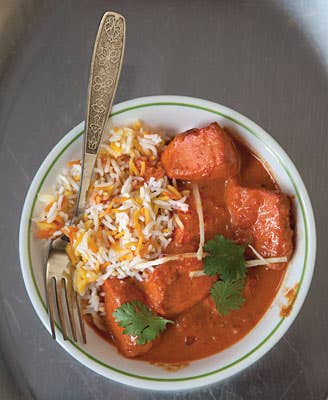
Special Sauce
Sometime in the 1970s, a customer in an Indian restaurant in Glasgow, Scotland, supposedly complained that the clay oven-baked chicken tikka he'd ordered was served without sauce, prompting the chef to improvise one from a can of tomato soup, a few spices, and a splash of cream. Thus was born the winning combination of fragrant, succulent chicken and creamy tomato gravy known as chicken tikka masala. At least, that's the story being advanced by a Scottish parliament minister who has applied on behalf of the city of Glasgow for Protected Designation of Origin status, which would mean that any reference to the dish would have to indicate its (as yet unproven) Glaswegian provenance.
Regardless of where it was invented, chicken tikka masala has, over the years, become a staple on Indian restaurant menus in the United Kingdom and a best-selling ready-made curry in the country's supermarkets, not to mention a popular pizza topping and sandwich filling. Some food critics have condemned it as inauthentic, insisting that the dish was unknown in India until restaurants there began serving it in imitation of restaurants in Britain. I would argue that chicken tikka masala actually belongs to a long and illustrious line of South Asian dishes that have been reinterpreted throughout the colonial and post-colonial worlds, giving rise to a distinct, Anglo-Indian style of cookery.
The dish's main component, chicken tikka, or boneless chicken pieces marinated in a mixture of yogurt and spices and then cooked in a clay tandoor oven, is itself a classic Punjabi dish. The tandoor imparts a smoky flavor to the chicken, which acquires a vivid orange or scarlet hue from turmeric, cayenne, or, often, food coloring in the marinade. Tandoor ovens gained a higher profile internationally after the restaurateur Kundan Lal Gujral built one in 1947 at Moti Mahal, his legendary restaurant in Delhi, a favorite of Indian statesmen and visiting dignitaries. The restaurant's signature dish was murgh makhani (butter chicken): tandoor-baked chicken in a sauce made with leftover marinade, butter, and tomatoes. It is possible that the cook who "invented" chicken tikka masala was attempting to replicate Moti Mahal's famous sauce. That he used canned soup to do it was very much in keeping with the convenience-minded British cooking of the postwar period.
Today, many chefs in the UK and elsewhere opt for fresh tomatoes instead of canned; some also enrich the sauce with ground almonds and substitute more-fragrant coconut milk for cream. Home cooks, too, have furthered the evolution by grilling or broiling the chicken to reproduce the tandoor-baked flavor. While the exact lineage of chicken tikka masala remains a subject of heated debate in some quarters, I regard it with affection as an example of the dynamic, mongrel nature of Indian food.
Keep Reading
Continue to Next Story










